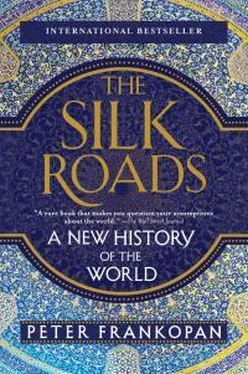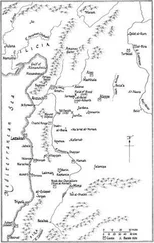These stirring stories fall into a category of literature seeking to establish the superiority of Christian customs and beliefs over traditional practices. Sources are scant, but we can get a sense of the propaganda battles being fought at the time. Unlike the other inhabitants of Persia, wrote one author, the “disciples of Christ” in Asia “do not practise the condemnable habits of these pagan peoples.” This was to be welcomed, noted another writer, as a sign of how Christians improved standards in Persia and elsewhere in the east; “Persians who have become His disciples no longer marry their mothers,” while those on the steppes no longer “feed on human flesh, because of Christ’s word which has come to them.” Such developments ought to be warmly welcomed, he wrote.53
It was the growing penetration and visibility of Christians in Persia in the middle of the third century that caused the Zoroastrian priesthood to react with increasing violence, echoing the response in the Roman Empire.54 But as Kirdīr’s inscription testifies, attitudes in Persia were starting to harden not just to Christianity but to other faiths too. Stamping out alternative cosmologies went hand in hand with the fervent Zoroastrianism that characterised the resurgence of Persia. A state religion was starting to emerge, one that identified Zoroastrian values as synonymous with Persian and provided what has been called “a supporting pillar of Sasanian kingship.”55
A series of chain reactions had been set in motion, whereby competition for resources and military confrontation prompted the development of sophisticated belief systems that not only made sense of victories and success, but directly undermined those of neighbouring rivals. In the case of Persia, this meant an increasingly strident and self-confident priesthood whose role extended deep into the sphere of politics—as the inscriptions make clear.
This inevitably had consequences, especially when it was exported into border regions or newly conquered territories. Setting up the fire temples of which Kirdīr was so proud not only risked antagonising local populations but also enforced doctrine and faith by force. Zoroastrianism became synonymous with Persia. It did not take much for this religion to be seen as a tool of occupation rather than a form of spiritual liberation. It was no coincidence, then, that some began to look to Christianity precisely as an antidote to the heavy-handed promotion of beliefs from the Persian centre.
The precise circumstances of how and when rulers in the Caucasus adopted Christianity are not entirely clear. Accounts of the conversion of the Armenian King Tiridates III at the start of the fourth century were written some time later—and owe something to the desire to tell a good story as well as to the Christian bias of their authors.56 But, according to tradition, Tiridates converted after turning into a pig and roaming naked in fields before being healed by St. Gregory, who had been thrown into a snake-infested pit for refusing to worship an Armenian goddess. Gregory healed Tiridates by causing his snout, tusks and skin to fall off before baptising the grateful monarch in the Euphrates.57
Tiridates was not the only important political figure to embrace Christianity in this period, for in the early fourth century Constantine, one of the most influential figures in Rome, also converted. The decisive moment came during a tempestuous civil war when Constantine took on his rival Maxentius at Milvian Bridge in central Italy in 312 AD. Shortly before the battle, the former supposedly gazed into the sky and saw “a cross-shaped light” above the sun, together with Greek words declaring “by this sign, you will conquer.” The full meaning of this became clear to him after he had a dream in which an apparition of Jesus Christ explained to him that the sign of the cross would help him defeat all his rivals. This, at any rate, was how some liked to describe what had happened.58
Christian accounts leave little doubt about the limitless enthusiasm with which the Emperor personally oversaw the enforcement of Christianity at the expense of all other religions. We learn from one author, for example, that the new city of Constantinople was not “polluted by altars, Grecian temples or pagan sacrifices,” but enriched by “splendid houses of prayer in which God promised to bless the efforts of the Emperor.”59 Another writer states that famous centres for cults were shut down by the Emperor, while oracles and divination, staple features of Roman theology, were banned. The customary sacrifice made before official business could take place was likewise outlawed, while pagan statues were pulled down and legislated against.60 There was little room for equivocation in the story told by authors with vested interests to show Constantine as single-minded promoter of his new beliefs.
In fact, Constantine’s motivations for conversion were certainly more complex than the accounts written during his lifetime or shortly afterwards like to suggest. For one thing, taking on the Christian faith adopted by large numbers in the military was shrewd politics; for another, monuments, coins and inscriptions from around the empire which depict Constantine as a staunch supporter of the cult of the Undefeated Sun (or Sol Invictus) suggest that his epiphany was perhaps more tentative than the breathless eulogies make out. Moreover, despite assertions to the contrary, the empire did not change character overnight, for leading figures in Rome, Constantinople and elsewhere continued following their traditional beliefs long after the Emperor’s revelation and the enthusiastic way he set about supporting his new faith.61
Nevertheless, Constantine’s acceptance of Christianity clearly brought about a sea change in the Roman Empire. The persecutions that had peaked during the reign of Diocletian just a decade or so earlier came to an end. Gladiator fights, long the staple of Roman entertainment, were abolished as a result of Christian revulsion at displays that so devalued the sanctity of life. “Bloody spectacles displease us,” reads an extract of a law passed in 325 and recorded in a later compilation of imperial legislation. “We [therefore] wholly forbid the existence of gladiators.” Those who had previously been sent into the arena as punishment for crimes they had committed or beliefs they refused to abandon were henceforth to be sent to “serve in the mines, so that they will assume the penalty for their crimes without shedding their blood.”62
As resources were lavished on supporting Christianity across the empire, Jerusalem was singled out for massive building works, complete with extravagant endowments. If Rome and Constantinople were administrative centres of the empire, Jerusalem was to be its spiritual heart. Parts of the city were flattened and soil dug out from beneath pagan temples was dumped as far away as possible, “stained as it was by devil worship.” Excavations now revealed one holy place after another, including the cave where Jesus had been laid to rest, which was renovated and, “like our Saviour, restored to life.”63
Constantine took charge of these works himself, directing what materials should be used in the construction of a church on the site of the Holy Sepulchre. The Emperor had been willing to delegate the choice of fabrics and the adornment of the walls to an appointee, but he wanted to be involved in the type of marble to be used, and in the selection of columns. “I should like to know your opinion,” he wrote to Macarius, the bishop of Jerusalem, “whether the ceiling should be panelled or decorated in another style of some kind. If it is panelled, it might also be decorated with gold.” Such choices, he went on, required his personal approval.64
Constantine’s celebrated conversion marked the start of a new chapter in the history of the Roman Empire. Although Christianity was not made a state religion, the easing of restrictions and punishments opened the floodgates for the new faith. This was good news for Christians and Christianity in the west, but it led to disaster for Christianity in the east. Although to start with Constantine was a tactful convert, issuing coins bearing distinctly pagan images and erecting a statue of himself as Helios-Apollo in his new city, he soon became more strident.65 Before long, he was portraying himself as the protector of Christians wherever they were—including outside the Roman Empire.
Читать дальше











